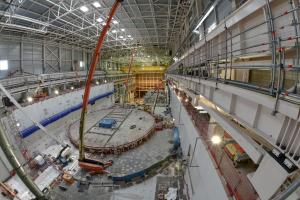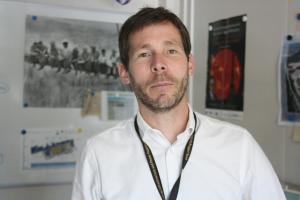Bâtiment
Fusion for Energy aux commandes
29 juil 2020
-
Esther Leburgue
Quiconque emprunte la route qui mène à ITER prend la mesure du projet exceptionnel quelques kilomètres avant d'arriver à destination. Les grues immenses apparaissent déjà, perchées sur une plateforme de 42 hectares, véritable estrade où le spectateur ne sait où poser le regard. Les constructions sortent de terre les unes après les autres, suivant le tempo de l'agence européenne Fusion for Energy.
Les équipes de Fusion for Energy ont marqué une étape importante fin mars 2020, quand elles ont livré l'arène d'assemblage (le Bâtiment tokamak + le Bâtiment d'assemblage) à ITER Organization dans les délais prévus.
Pleins feux sur la plateforme en ce chaud après-midi de juin. Grues, engins de chantiers, ouvriers... autant de témoins d'une activité intense alors que la période de crise sanitaire liée à l'épidémie de coronavirus a fortement diminué les effectifs sur le site. ITER avance sans relâche et comptera à terme 39 bâtiments scientifiques et auxiliaires qui hébergeront la machine et les systèmes de l'installation ITER (soit 10 millions de pièces fabriquées dans les usines des sept membres de ITER). Autant de projets dans le projet pour Laurent Schmieder, en charge de l'unité Site, bâtiments et alimentation électrique chez Fusion for Energy, l'agence qui orchestre la contribution de l'Union Européenne au projet ITER.
Pour l'heure, la feuille de route est respectée du côté de la construction et devrait permettre d'atteindre cette échéance tant attendue de décembre 2025, date à laquelle ITER produira son premier plasma. « En termes de budget, nous avons attribué environ ⅔ du montant de nos marchés, explique Laurent Schmieder. Et en termes de construction, si nous nous concentrons sur les bâtiments nécessaires pour le premier plasma, nous atteignons 70 à 80 % ».
En allant crescendo
Surtout, les équipes de Fusion for Energy ont franchi une étape décisive fin mars avec la livraison de la zone d'assemblage à ITER Organization alors que l'activité était presque à l'arrêt en France et dans de nombreux autres pays. « C'était un sacré challenge, confirme Laurent Schmieder. Tout était réglé comme du papier à musique mais nous avons eu une météo peu clémente l'année dernière, des incidents... Quelques semaines avant la date butoir, le COVID-19 nous est tombé dessus ! » Si d'ordinaire près de 2 500 personnes sont présentes sur le site — incluant maîtrise d'œuvre, maîtrise d'ouvrage, entreprises et bureaux d'études — les effectifs sont passés à quelques dizaines les premières semaines, puis quelques centaines et remontent désormais progressivement.
Laurent Schmieder est en charge de l'unité Site, bâtiments et alimentation électrique chez Fusion for Energy, l'agence qui orchestre la contribution de l'Union Européenne au projet ITER.
« Nous avons eu la chance de bénéficier du support de l'État français grâce à l'appui du Directeur Général et nous avons obtenu les dérogations nécessaires », explique Laurent Schmieder. Le bâtiment a donc été livré en temps et en heure, délivrant d'un stress considérable les équipes concernées. « Cet objectif de fin mars était important car jusqu'à présent, les attentes les plus pressantes pour la réalisation du projet ont concerné sur le bâtiment. Depuis ce jour-là, elles sont partagées avec nos collègues responsables de l'assemblage », poursuit-il. Cette livraison sans fausse note a permis depuis de commencer à assembler la machine dans le bâtiment tokamak.
Jeu de chaises musicales
La crise sanitaire perturbe néanmoins les livraisons à venir. « Nous avons alloué toutes les ressources disponibles à la livraison du théâtre d'assemblage. Les installations électriques et des postes de transformation devraient être livrés entre août ou septembre au lieu de juin. Pour les livraisons plus lointaines, nous devrions rattraper le retard », estime Laurent Schmieder.
Les équipes « bâtiments » d'ITER Organization et Fusion for Energy se réorganisent progressivement sur les nouveaux challenges. Celles qui œuvraient au génie civil du Bâtiment tokamak se concentrent notamment sur le bâtiment cellule chaude, représentant les marchés les plus importants restant à signer après fin 2020, pour 500 millions d'euros. « La cellule chaude n'a pas été la priorité jusqu'à aujourd'hui, explique Laurent Schmieder, car nous nous sommes d'abord focalisés sur les éléments nécessaires au premier plasma prévu en décembre 2025. Mais maintenant, il faut avancer parce nous devons le livrer dans sept ans. »
D'autres constructions, essentielles quant à elles pour le premier plasma progressent, notamment celle dédiée au bâtiment de contrôle et les ponts qui permettront la connexion entre les bâtiments de conversion électrique et le tokamak. En déambulant sur le site, d'autres bâtiments presque achevés entourent le Bâtiment tokamak comme l'usine cryogénique et la zone de rejet thermique, où ne restent que des finitions à réaliser et puis certaines avancées, comme les réseaux sous-terrain, se font à l'abri des regards, sans tambour ni trompette. Quant aux équipes « bâtiments » de Fusion for Energy, si elles auront dévoilé la plupart de leurs réalisations à la date du premier plasma, elles restent mobilisées à ITER jusqu'à horizon 2028-2030 pour livrer l'ensemble des constructions.



